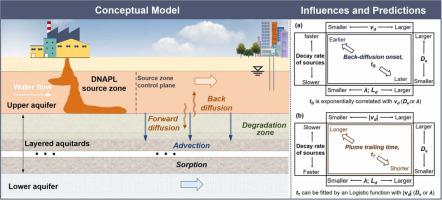Journal of Hazardous Materials ( IF 12.2 ) Pub Date : 2022-06-18 , DOI: 10.1016/j.jhazmat.2022.129410 Xiang-Hong Ding 1 , Shi-Jin Feng 2

|
Aquitards contaminated by chlorinated solvents may act as a secondary source slowly releasing contaminants into adjacent aquifers, thus severely hampering the remediation of groundwater systems. Accurate predicting the long-term exchange of solvents between aquifers and aquitards can more effectively guide site management and remediation. This study presented a general analytical model for the back-diffusion of chlorinated solvents through multilayer aquitards. This model considers the slow advection and local degradation of dissolved constituents in natural aquitards and the dynamic depletion of dense nonaqueous phase liquid (DNAPL) source zone in aquifers. Transient solutions for the proposed multilayer model were derived using Duhamel’s Theorem, the separation of variables method, and the transfer matrix method, verified against experimental and numerical concentration data. Results reveal that advection in aquitards can significantly shorten the trailing time of chlorinated solvent plumes, and highly adsorptive soils may reduce this effect in layered aquitards. The previous no-degradation model is no longer applicable to predict the back-diffusion behavior of chlorinated solvents when the extent and rate of solvent degradation are large, giving a “strong-effect zone”. Based on numerous example simulations and data fitting, the forecast functions for the back-diffusion onset time and plume trailing time were proposed, greatly facilitating remediation decisions and risk assessment of chlorinated-solvent contaminated sites.
中文翻译:

研究平流和降解在多层隔水层氯化溶剂反扩散中的作用:一种新的分析方法
被氯化溶剂污染的透水层可能成为第二个来源,将污染物缓慢释放到相邻的含水层中,从而严重阻碍地下水系统的修复。准确预测含水层和隔水层之间的长期溶剂交换可以更有效地指导场地管理和修复。本研究为氯化溶剂通过多层隔水层的反扩散提供了一个通用分析模型。该模型考虑了天然隔水层中溶解成分的缓慢平流和局部降解以及含水层中致密非水相液体 (DNAPL) 源区的动态消耗。所提出的多层模型的瞬态解是使用 Duhamel 定理、变量分离方法和传递矩阵方法得出的,对照实验和数值浓度数据进行验证。结果表明,隔水层中的平流可以显着缩短氯化溶剂羽流的拖尾时间,而高吸附性土壤可能会降低层状隔水层中的这种效应。当溶剂降解的程度和速率较大时,以前的无降解模型不再适用于预测氯化溶剂的反扩散行为,从而给出“强效应区”。基于大量实例模拟和数据拟合,提出了反扩散开始时间和羽流拖尾时间的预测函数,极大地促进了氯溶剂污染场地的修复决策和风险评估。结果表明,隔水层中的平流可以显着缩短氯化溶剂羽流的拖尾时间,而高吸附性土壤可能会降低层状隔水层中的这种效应。当溶剂降解的程度和速率较大时,以前的无降解模型不再适用于预测氯化溶剂的反扩散行为,从而给出“强效应区”。基于大量实例模拟和数据拟合,提出了反扩散开始时间和羽流拖尾时间的预测函数,极大地促进了氯溶剂污染场地的修复决策和风险评估。结果表明,隔水层中的平流可以显着缩短氯化溶剂羽流的拖尾时间,而高吸附性土壤可能会降低层状隔水层中的这种效应。当溶剂降解的程度和速率较大时,以前的无降解模型不再适用于预测氯化溶剂的反扩散行为,从而给出“强效应区”。基于大量实例模拟和数据拟合,提出了反扩散开始时间和羽流拖尾时间的预测函数,极大地促进了氯溶剂污染场地的修复决策和风险评估。当溶剂降解的程度和速率较大时,以前的无降解模型不再适用于预测氯化溶剂的反扩散行为,从而给出“强效应区”。基于大量实例模拟和数据拟合,提出了反扩散开始时间和羽流拖尾时间的预测函数,极大地促进了氯溶剂污染场地的修复决策和风险评估。当溶剂降解的程度和速率较大时,以前的无降解模型不再适用于预测氯化溶剂的反扩散行为,从而给出“强效应区”。基于大量实例模拟和数据拟合,提出了反扩散开始时间和羽流拖尾时间的预测函数,极大地促进了氯溶剂污染场地的修复决策和风险评估。











































 京公网安备 11010802027423号
京公网安备 11010802027423号